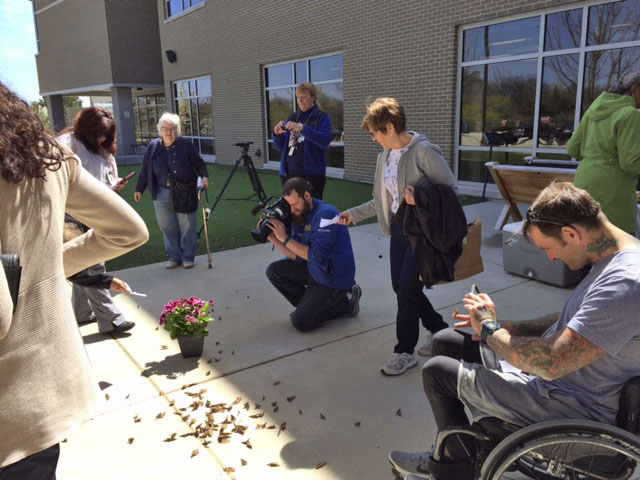Veterans Health Administration
Butterflies Symbolize Hope for Paralyzed Veterans

Flowers and Sunshine help revive dozens of cold, grounded butterflies during a special ceremony at the Milwaukee VA’s Spinal Cord Injury building in early May.
On a cold but sunny morning in early May, about 30 patients and staff gathered on the front patio of the Milwaukee VA’s Spinal Cord Injury building. Many of the patients were in wheelchairs.
“We were there to release some butterflies,” explained Army Veteran Scott Griffith. “It was Ependymoma Awareness Day, and we wanted to give our Ependymoma patients an emotional boost. For us the butterfly symbolizes change, and hope.”
“I’m still alive because of the VA.”
The event was put on by the Paralyzed Veterans of America, the organization Griffith works for.
“I was diagnosed with Ependymoma 18 years ago, and I’m still alive because of the VA,” he said. “A lot of Veterans with this disease and other spinal cord injuries are still alive because of the VA. I know they’ve been getting a lot of bad press lately. But I have to say, when you’re looking for something the VA does right, this is one of them. They offer superb care for Veterans with spinal cord injuries. No one does it any better.”
Ependymoma is a cancerous tumor that forms on the brain or spinal cord. Its cause is unknown. Nearly 700,000 Americans had been diagnosed with it as of 2010.

They were holding hope in their hands
“The box that I opened had about 150 Painted Lady butterflies in it,” Griffith said. “They were shipped in from Texas. The idea was for them to all flutter into the air at once, but they were a little slow to wake up. They didn’t want to come out of the box.
“Apparently the Texas butterflies did not have a fondness for our Wisconsin weather,” he concluded. “The ideal temperature for releasing them is 70 to 75 degrees. It was about 58 here that morning.”
Not only did the sleepy little guys not fly; most of them ended up on the turf.
“They don’t move when they’re cold, so when we opened the box they just kind of flopped to the ground” said Dr. Kenneth Lee, an Army Veteran who heads up the Milwaukee VA’s Spinal Cord Injury unit. “They were just sitting on the grass not doing anything. It was sort of funny.”
But Lee, who was badly injured while serving in Iraq, knows how to find the silver lining in any situation.
“I think it was a blessing in disguise that they didn’t just fly away, because everyone started picking them up and putting them in the Veterans’ hands,” he said. “The symbolism was awesome... all these Veterans in wheelchairs, holding butterflies in their hands, watching them try to move their wings. It was like they were holding hope in their hands.”
Scott Griffith agreed. “You’ve got all these injury-hardened Veterans sitting in their wheelchairs, but then someone puts a fragile little butterfly in their hands and you can see these guys soften right up. They start grinning from ear to ear, like they were playing softball with their granddaughter or something.”
One of those smiling Veterans was Mike O’Leary, an Air Force Veteran and a patient at the Milwaukee VA.
“Some of the butterflies came individually packaged,” he said. “They were inside these little origami things, these little paper pouches. You held it by the corners and pulled it open, and there was your butterfly.”
Shock and Awe
But O’Leary’s little yellow friend was apparently just as sleepy as the rest of his winged associates.
“That poor butterfly,” he said. “It was so cold. I think he was in shock. When I first opened up the pouch and saw my butterfly I was elated. Then when he dropped to the ground I wasn’t so elated. I was worried about him. So I picked him up off the cold ground and held him for a while to get him warm.”
It seemed everyone was busy scooping up comatose butterflies from the ground as fast as they could. Suddenly, out of nowhere, a VA staffer appeared with a flowerpot full of bright red flowers. (Butterflies like flowers.)
“Everyone started putting their butterflies on the flowers,” said O’Leary. “So I put my little guy on the flowers where he could be with his friends. That gave me a good feeling.”
Julie Kronenburg, who works at the Spinal Cord Injury unit, said she thinks all the butterflies survived the morning’s festivities.
“The flowers helped, and the sunshine certainly helped,” she said. “They started to wake up once they were in the sun.”
About an hour after the ceremony ended, Kronenburg decided to return outside and check on the butterfly herd.
“I went back out there and they were all gone,” she said. “They all flew away. They’re Texas butterflies, so I hope they like Wisconsin.”
To learn more about what the VA is doing for Veterans with spinal cord injuries, visit http://www.sci.va.gov/



















